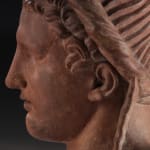Terracotta Bust of Demetrius | Poliocretes
French, First half 19th Century
A terracotta bust after the celebrated Hellenistic marble in the Capitoline Museums,
Rome. The original portrays Demetrius | Poliocretes (337-283 BC), one of Alexander the
Great’s successors, distinguished by his broad features and the royal diadem -
misattributed as Ptolemy.
Height: 44cm Width: 25cm Depth: 17cm
This terracotta bust follows the monumental marble in the Capitoline Museums, Rome,
traditionally identified as Demtrius | Poliocretes (c.337-283 BC), son of Antigonus |
Monophtalmus and one of Alexander the Great’s successors. Demetrius earned the
epithet Poliocretes (‘The Besiseger’) for his famed military campaigns. His portrait type
is characterised by heavy-lidded eyes, strong facial modelling and the distinctive royal
diadem, here shown knotted with long pendant ties falling over the shoulders.
An inscription reading ‘PTOLOMEE’ is incised on the base of this bust, reflecting an
early misattribution to the Ptolemaic dynasty. Such errors were not uncommon in the
18th and 19th century cast collections. Now reattributed.
A terracotta bust after the celebrated Hellenistic marble in the Capitoline Museums,
Rome. The original portrays Demetrius | Poliocretes (337-283 BC), one of Alexander the
Great’s successors, distinguished by his broad features and the royal diadem -
misattributed as Ptolemy.
Height: 44cm Width: 25cm Depth: 17cm
This terracotta bust follows the monumental marble in the Capitoline Museums, Rome,
traditionally identified as Demtrius | Poliocretes (c.337-283 BC), son of Antigonus |
Monophtalmus and one of Alexander the Great’s successors. Demetrius earned the
epithet Poliocretes (‘The Besiseger’) for his famed military campaigns. His portrait type
is characterised by heavy-lidded eyes, strong facial modelling and the distinctive royal
diadem, here shown knotted with long pendant ties falling over the shoulders.
An inscription reading ‘PTOLOMEE’ is incised on the base of this bust, reflecting an
early misattribution to the Ptolemaic dynasty. Such errors were not uncommon in the
18th and 19th century cast collections. Now reattributed.
£ 12,450.00
Further images
-
(View a larger image of thumbnail 1
)

-
(View a larger image of thumbnail 2
)

-
(View a larger image of thumbnail 3
)

-
(View a larger image of thumbnail 4
)

-
(View a larger image of thumbnail 5
)

-
(View a larger image of thumbnail 6
)

-
(View a larger image of thumbnail 7
)

-
(View a larger image of thumbnail 8
)








